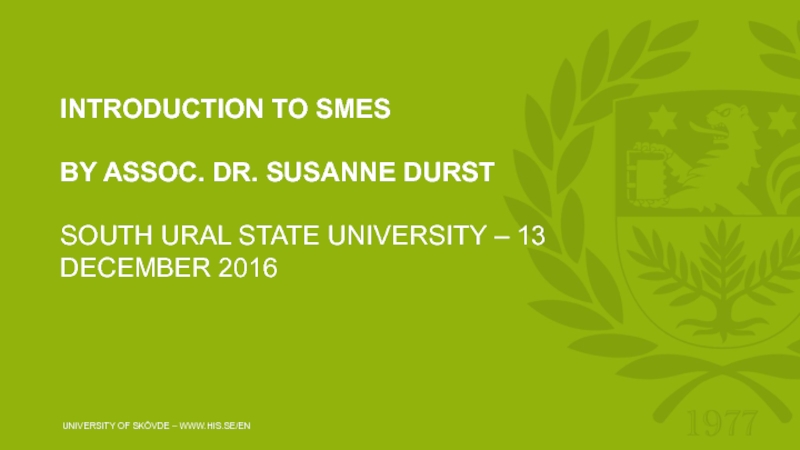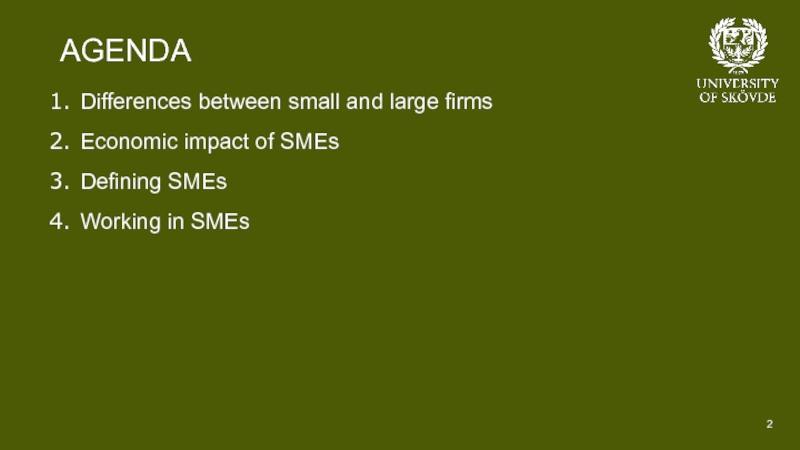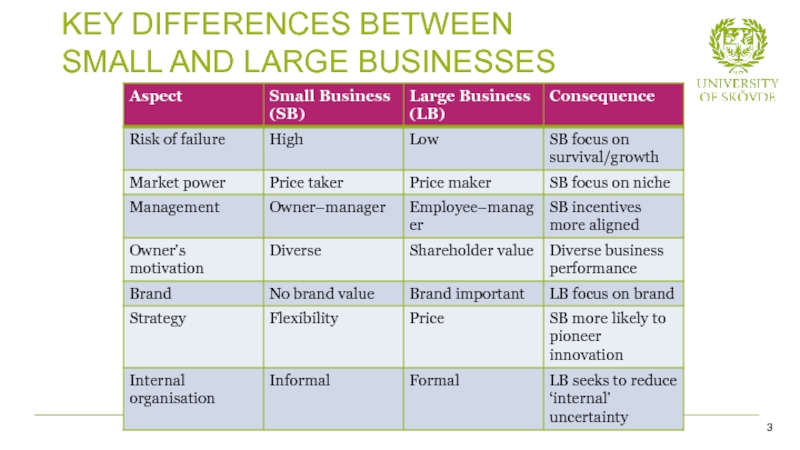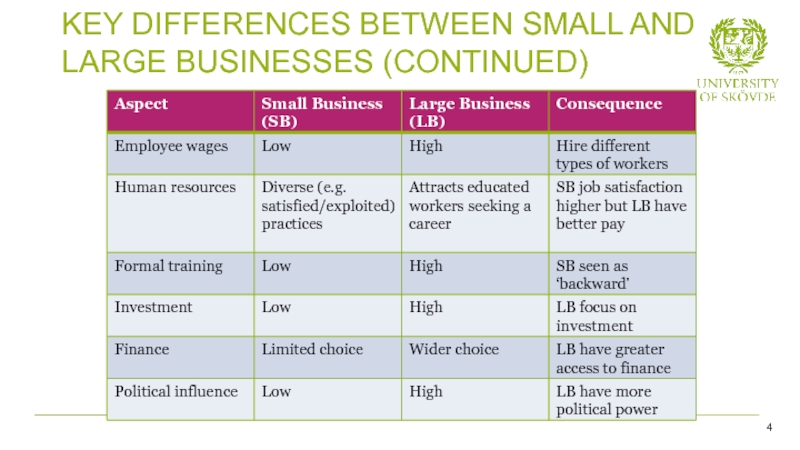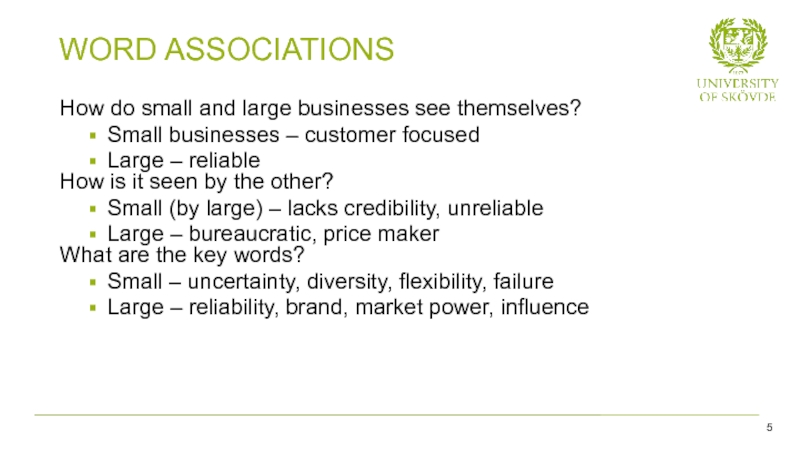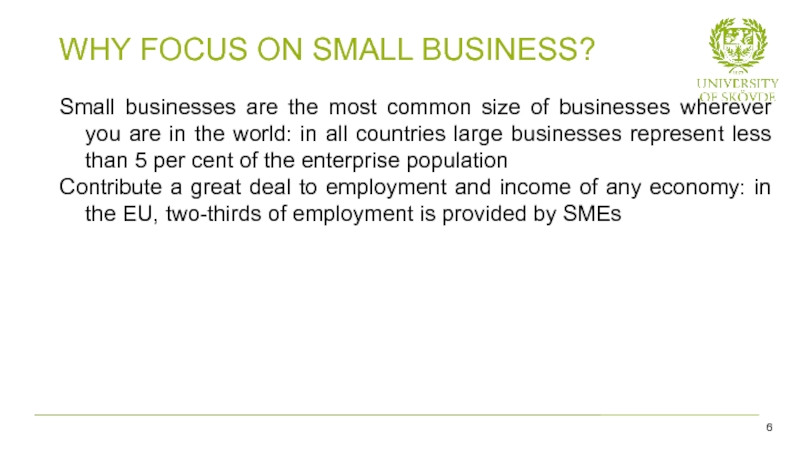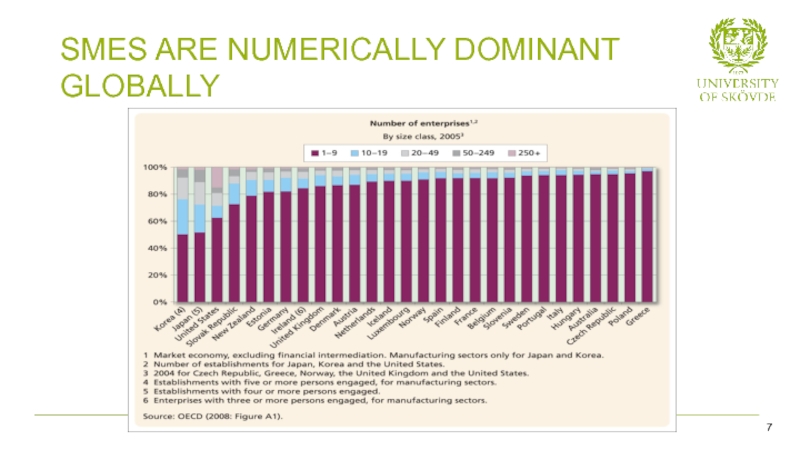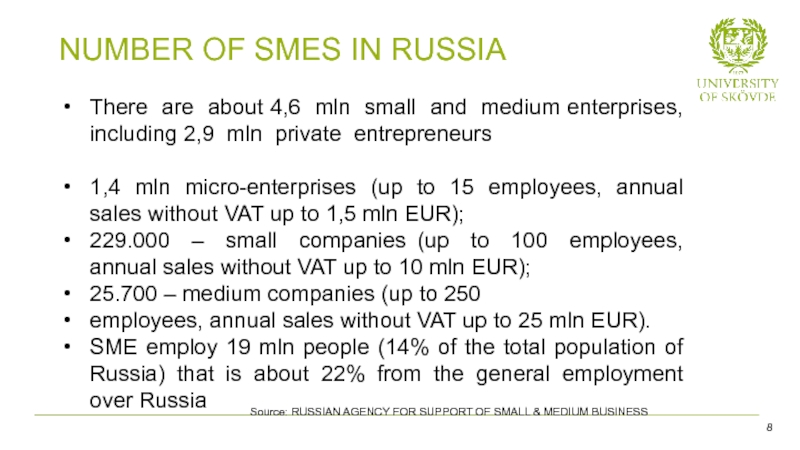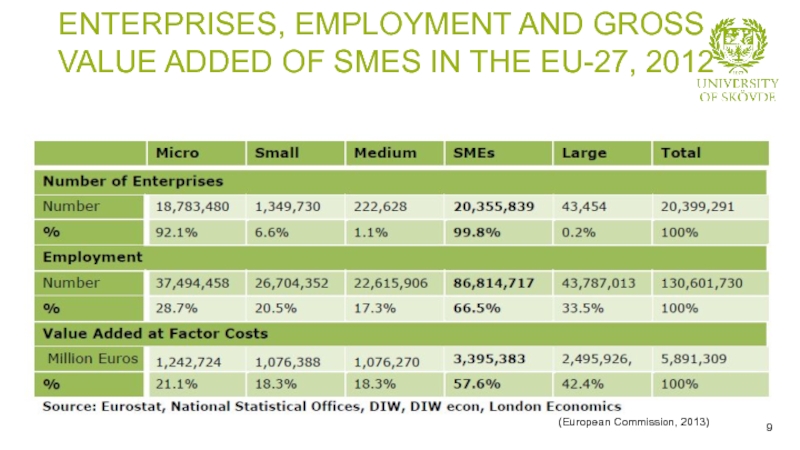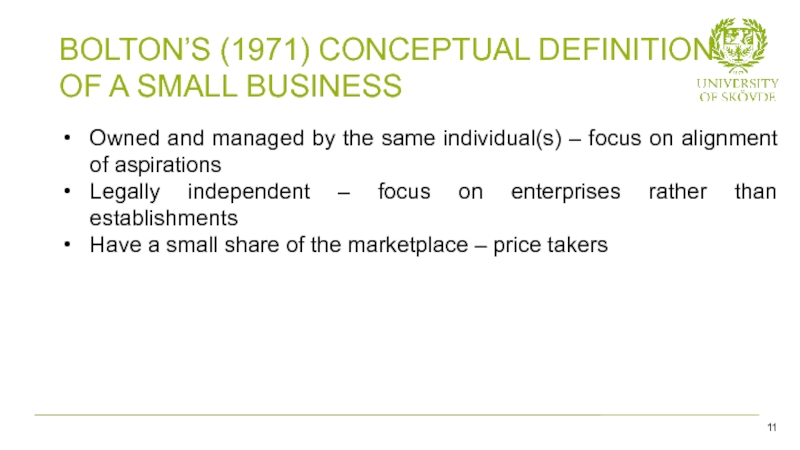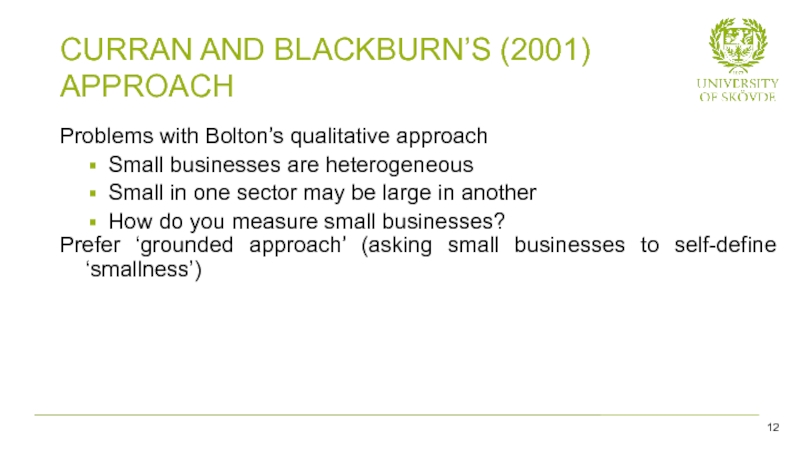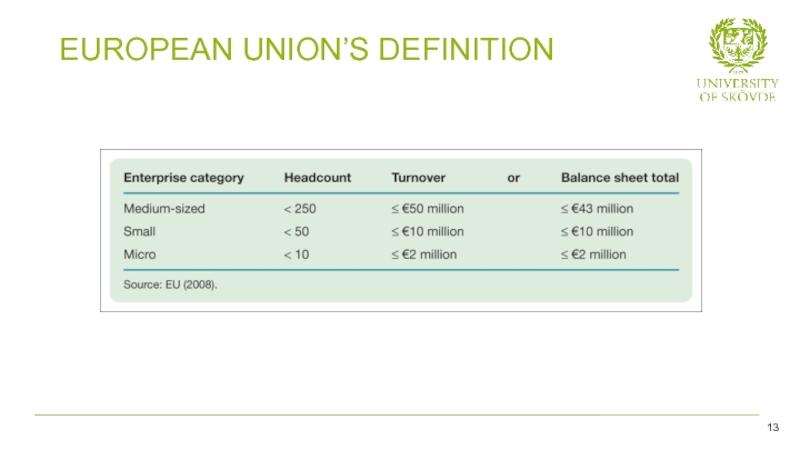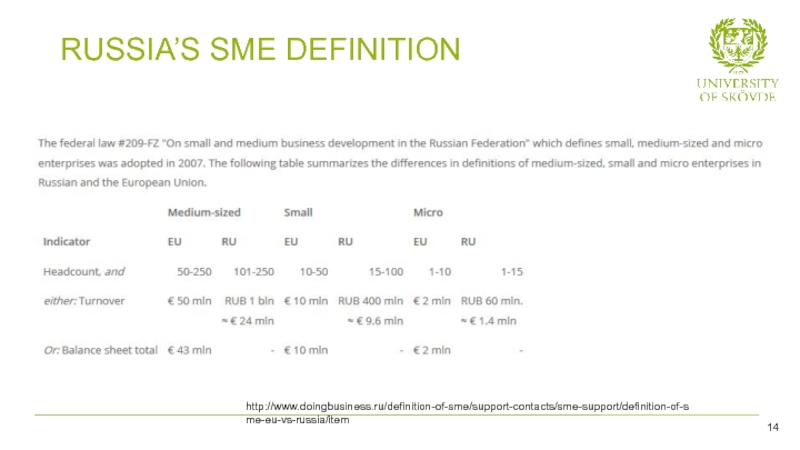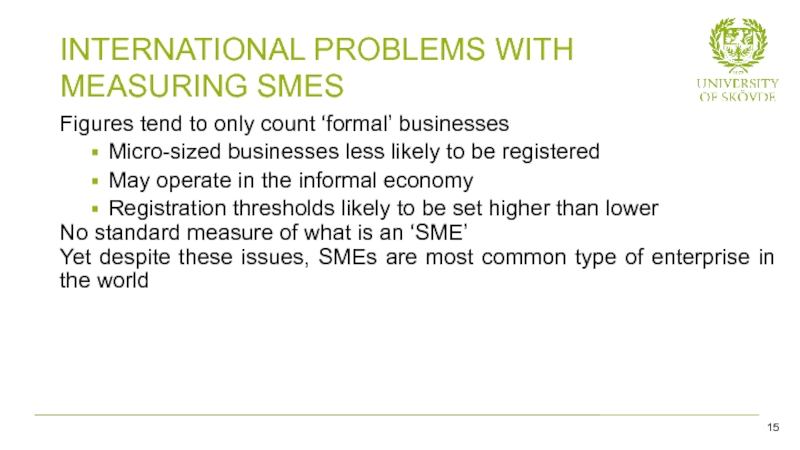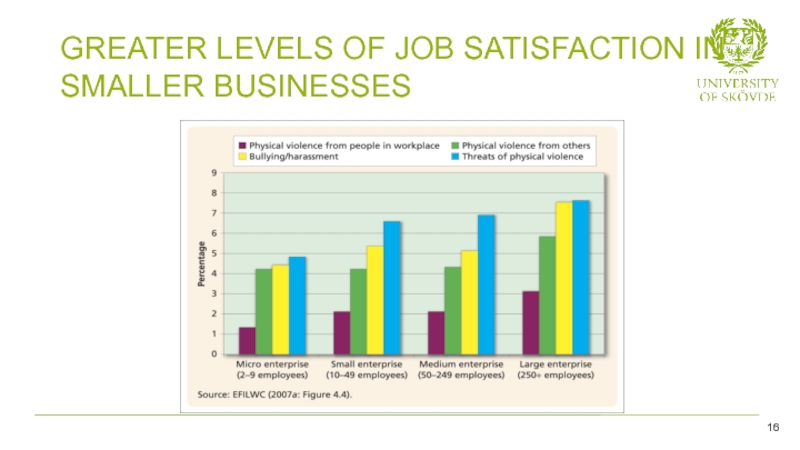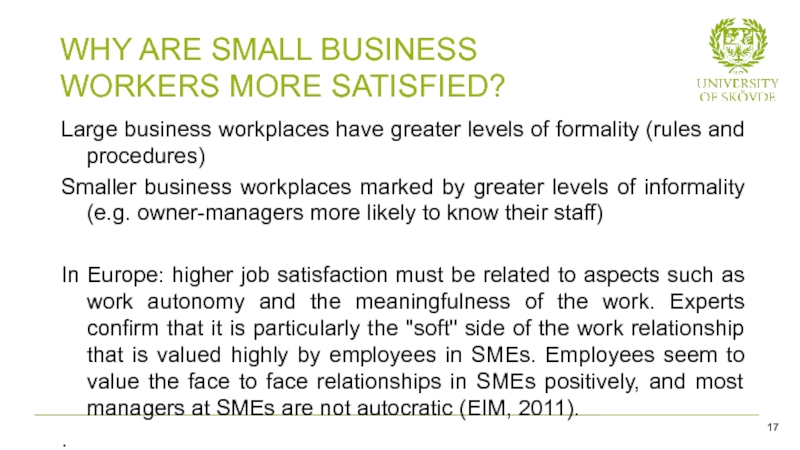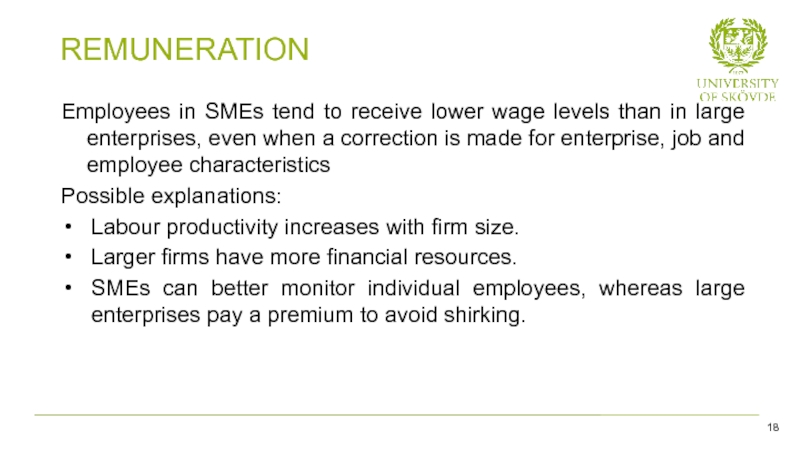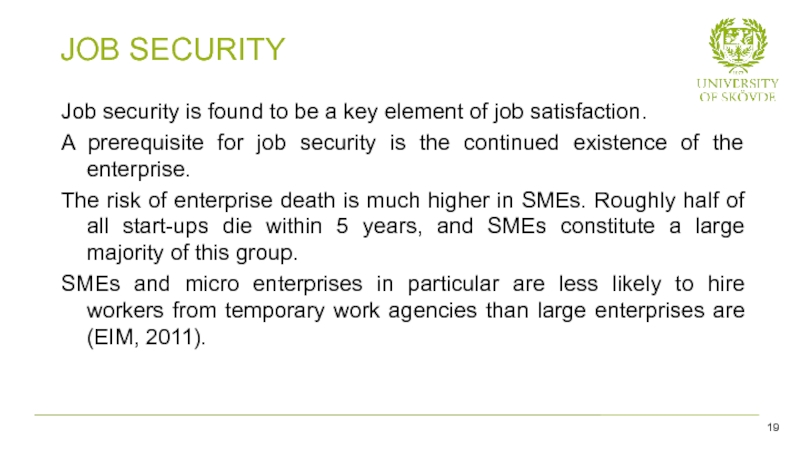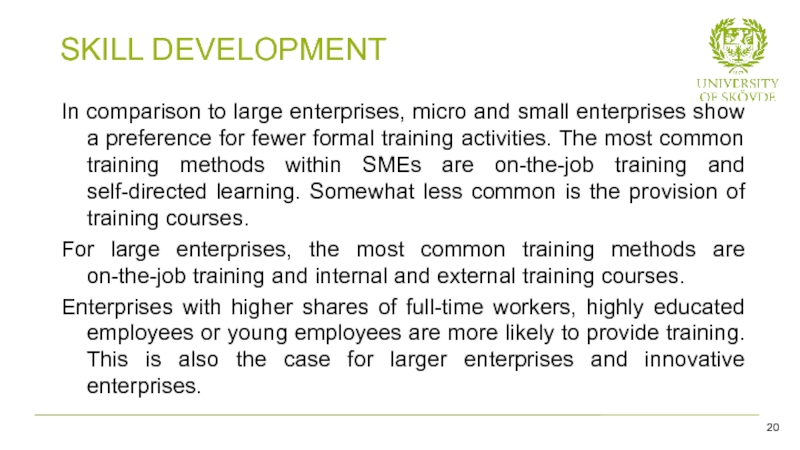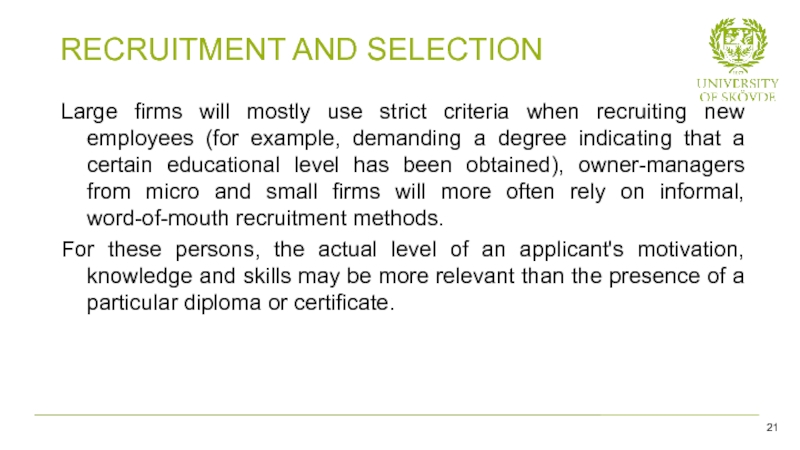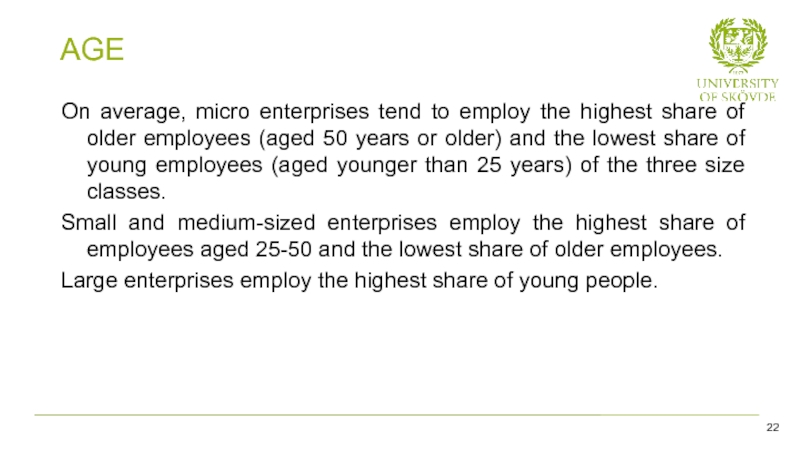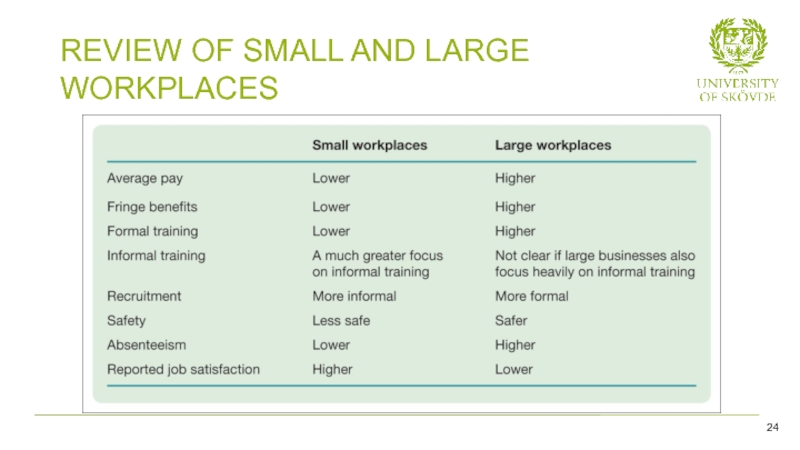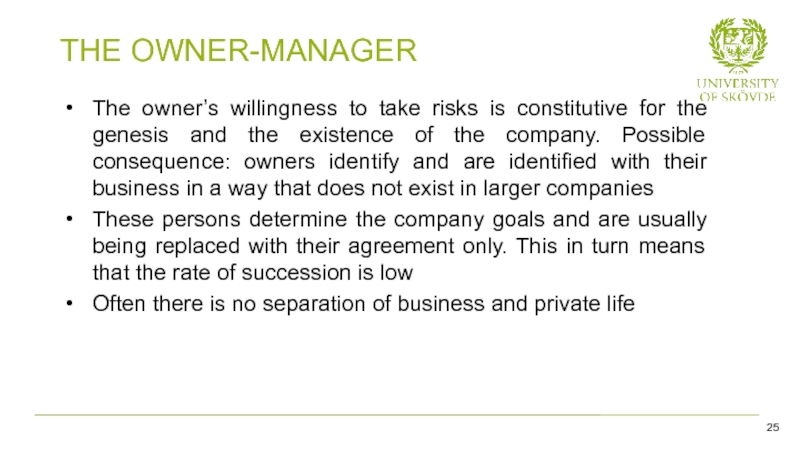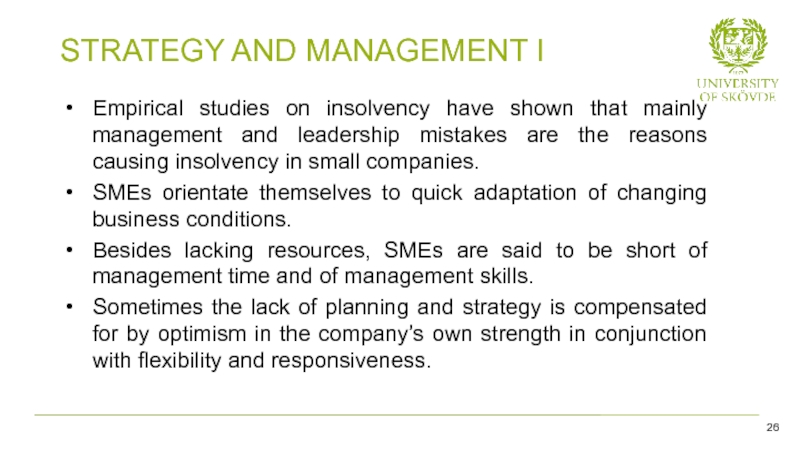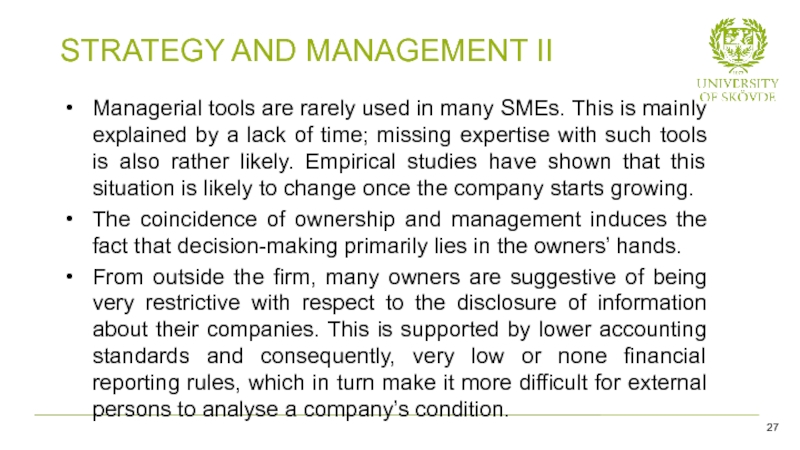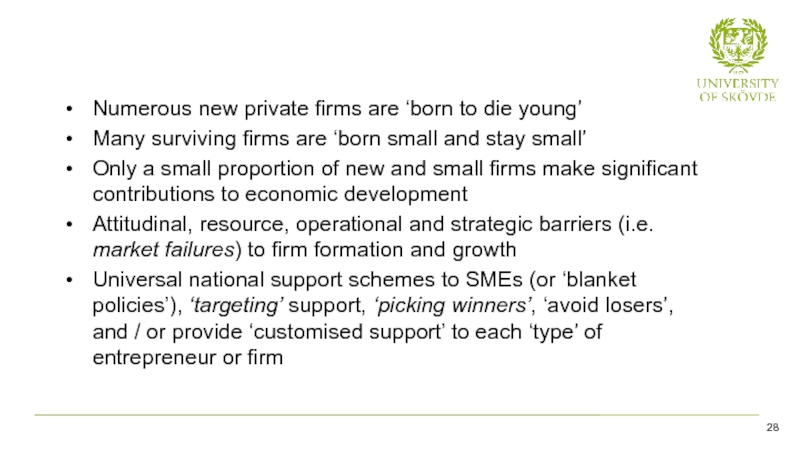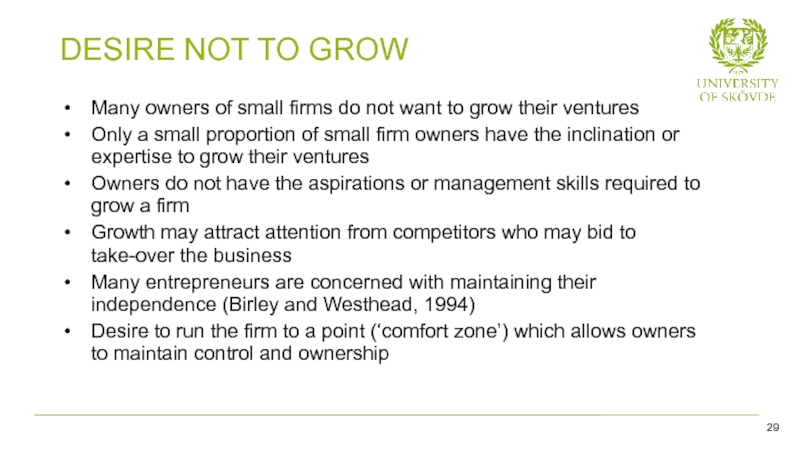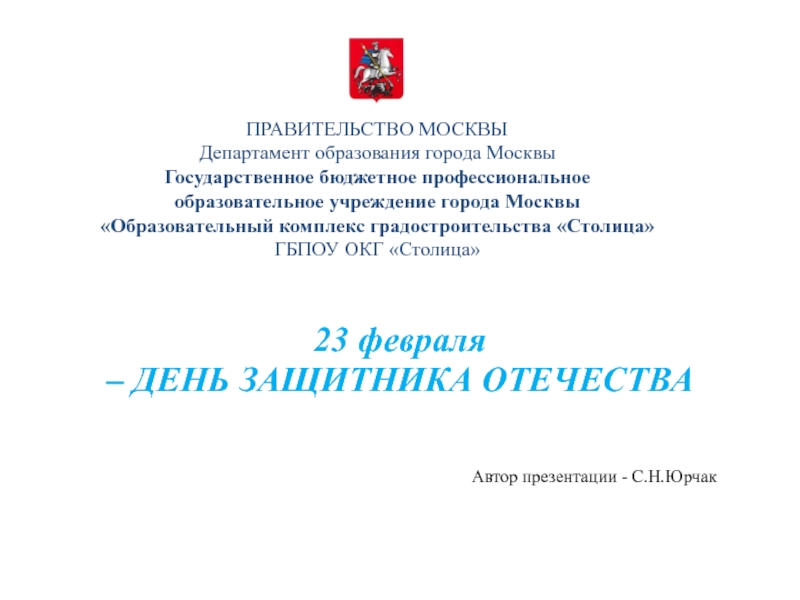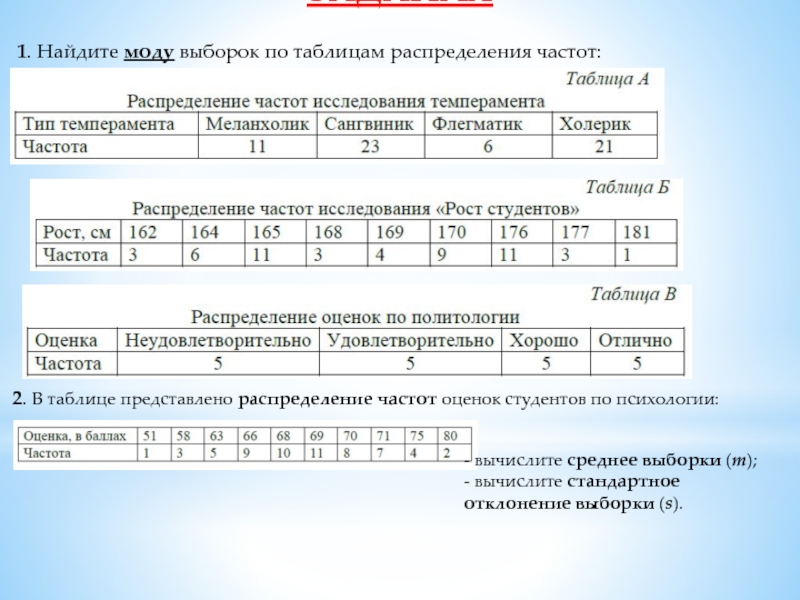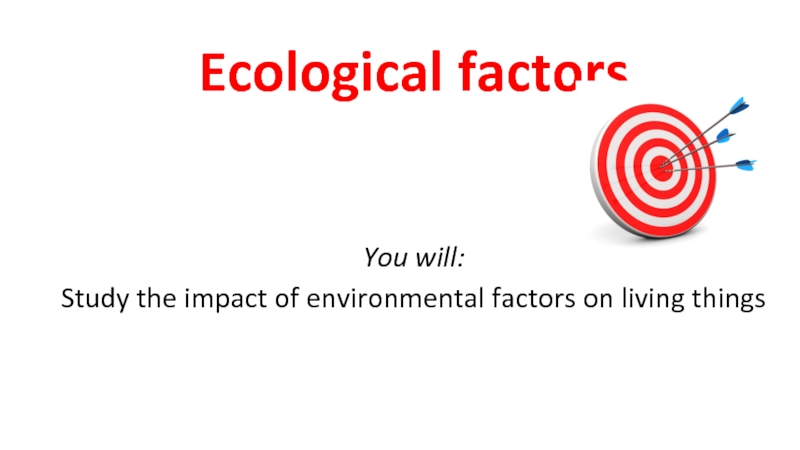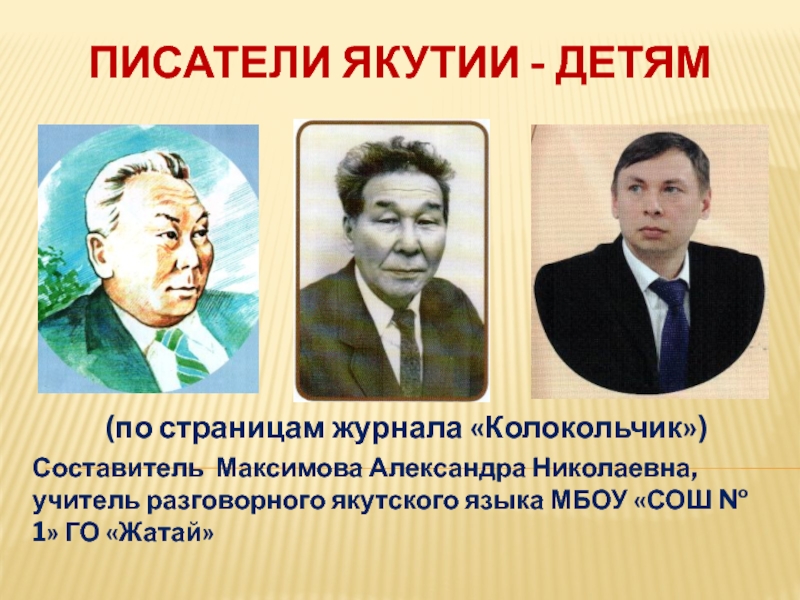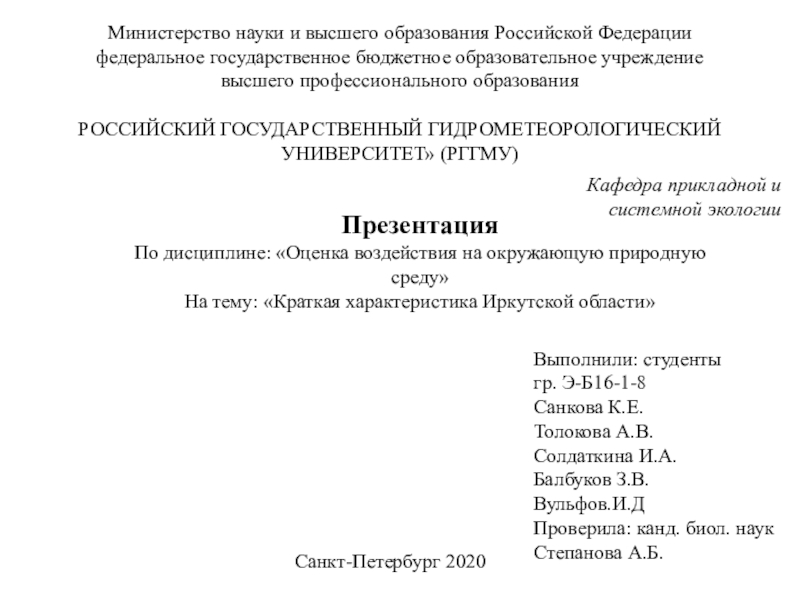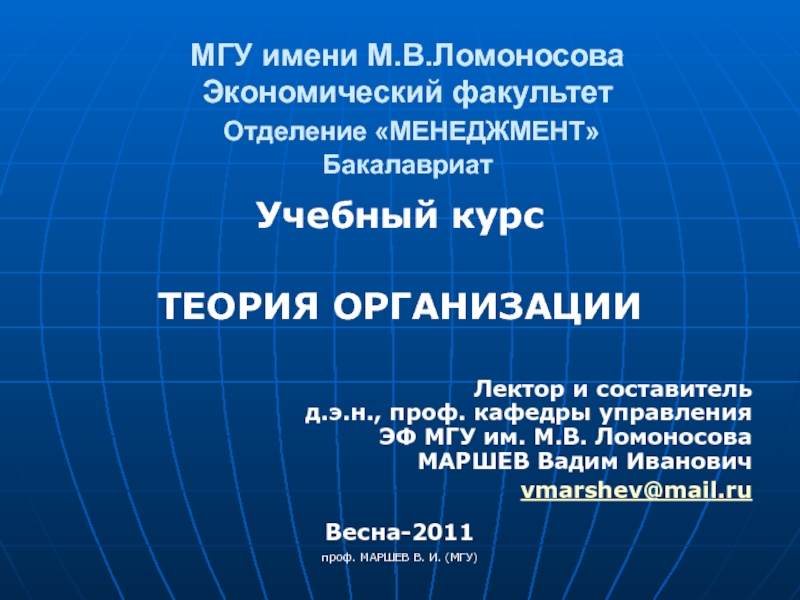Разделы презентаций
- Разное
- Английский язык
- Астрономия
- Алгебра
- Биология
- География
- Геометрия
- Детские презентации
- Информатика
- История
- Литература
- Математика
- Медицина
- Менеджмент
- Музыка
- МХК
- Немецкий язык
- ОБЖ
- Обществознание
- Окружающий мир
- Педагогика
- Русский язык
- Технология
- Физика
- Философия
- Химия
- Шаблоны, картинки для презентаций
- Экология
- Экономика
- Юриспруденция
Introduction TO SMEs By Assoc. Dr. Susanne DursT South Ural State University –
Содержание
- 1. Introduction TO SMEs By Assoc. Dr. Susanne DursT South Ural State University –
- 2. Agenda2Differences between small and large firmsEconomic impact of SMEsDefining SMEsWorking in SMEs
- 3. Key differences between small and large businesses3
- 4. Key differences between small and large businesses (Continued)4
- 5. How do small and large businesses see
- 6. Small businesses are the most common size
- 7. SMEs are numerically dominant globally7
- 8. There are about 4,6 mln small and
- 9. Enterprises, Employment and Gross Value Added of SMEs in the EU-27, 2012(European Commission, 2013)9
- 10. Difficult because there are different ways of
- 11. Owned and managed by the same individual(s)
- 12. Problems with Bolton’s qualitative approachSmall businesses are
- 13. European Union’s definition13
- 14. Russia’s SME Definition14http://www.doingbusiness.ru/definition-of-sme/support-contacts/sme-support/definition-of-sme-eu-vs-russia/item
- 15. Figures tend to only count ‘formal’ businesses
- 16. Greater levels of job satisfaction in smaller
- 17. Why are small business workers more satisfied?Large
- 18. RemunerationEmployees in SMEs tend to receive lower
- 19. Job SecurityJob security is found to be
- 20. Skill DevelopmentIn comparison to large enterprises, micro
- 21. Recruitment and SelectionLarge firms will mostly use
- 22. AGEOn average, micro enterprises tend to employ
- 23. Review of small and large workplacesTable 4.4 Small and large workplaces: a review24
- 24. The owner-ManagerThe owner’s willingness to take risks
- 25. Strategy and Management IEmpirical studies on insolvency
- 26. Strategy and Management IIManagerial tools are rarely
- 27. Numerous new private firms are ‘born to
- 28. Desire Not to GrowMany owners of small
- 29. Скачать презентанцию
Слайды и текст этой презентации
Слайд 1Introduction TO SMEs By Assoc. Dr. Susanne DursT South Ural State University
– 13 December 2016
Слайд 2Agenda
2
Differences between small and large firms
Economic impact of SMEs
Defining SMEs
Working
in SMEs
Слайд 5How do small and large businesses see themselves?
Small businesses –
customer focused
Large – reliable
How is it seen by the
other?Small (by large) – lacks credibility, unreliable
Large – bureaucratic, price maker
What are the key words?
Small – uncertainty, diversity, flexibility, failure
Large – reliability, brand, market power, influence
Word associations
5
Слайд 6Small businesses are the most common size of businesses wherever
you are in the world: in all countries large businesses
represent less than 5 per cent of the enterprise populationContribute a great deal to employment and income of any economy: in the EU, two-thirds of employment is provided by SMEs
Why focus on small business?
6
Слайд 8There are about 4,6 mln small and medium enterprises, including
2,9 mln private entrepreneurs
1,4 mln micro-enterprises (up to 15 employees,
annual sales without VAT up to 1,5 mln EUR);229.000 – small companies (up to 100 employees, annual sales without VAT up to 10 mln EUR);
25.700 – medium companies (up to 250
employees, annual sales without VAT up to 25 mln EUR).
SME employ 19 mln people (14% of the total population of Russia) that is about 22% from the general employment over Russia
Number of SMES in Russia
8
Source: RUSSIAN AGENCY FOR SUPPORT OF SMALL & MEDIUM BUSINESS
Слайд 9Enterprises, Employment and Gross Value Added of SMEs in the
EU-27, 2012
(European Commission, 2013)
9
Слайд 10Difficult because there are different ways of classifying small business
activity
Self-employment – no agreed definition but does often involve four
elements:Control
Integration
Economic reality
Mutuality of obligation
Defining the small business
10
Слайд 11Owned and managed by the same individual(s) – focus on
alignment of aspirations
Legally independent – focus on enterprises rather than
establishmentsHave a small share of the marketplace – price takers
Bolton’s (1971) conceptual definition of a small business
11
Слайд 12Problems with Bolton’s qualitative approach
Small businesses are heterogeneous
Small in one
sector may be large in another
How do you measure small
businesses?Prefer ‘grounded approach’ (asking small businesses to self-define ‘smallness’)
Curran and Blackburn’s (2001) approach
12
Слайд 14Russia’s SME Definition
14
http://www.doingbusiness.ru/definition-of-sme/support-contacts/sme-support/definition-of-sme-eu-vs-russia/item
Слайд 15Figures tend to only count ‘formal’ businesses
Micro-sized businesses less
likely to be registered
May operate in the informal economy
Registration thresholds
likely to be set higher than lowerNo standard measure of what is an ‘SME’
Yet despite these issues, SMEs are most common type of enterprise in the world
International problems with measuring SMEs
15
Слайд 16Greater levels of job satisfaction in smaller businesses
Figure 4.4 Violence
and harassment, by business size, EU-27 (%)
16
Слайд 17Why are small business workers more satisfied?
Large business workplaces have
greater levels of formality (rules and procedures)
Smaller business workplaces
marked by greater levels of informality (e.g. owner-managers more likely to know their staff)In Europe: higher job satisfaction must be related to aspects such as work autonomy and the meaningfulness of the work. Experts confirm that it is particularly the "soft" side of the work relationship that is valued highly by employees in SMEs. Employees seem to value the face to face relationships in SMEs positively, and most managers at SMEs are not autocratic (EIM, 2011).
.
17
Слайд 18Remuneration
Employees in SMEs tend to receive lower wage levels than
in large enterprises, even when a correction is made for
enterprise, job and employee characteristicsPossible explanations:
Labour productivity increases with firm size.
Larger firms have more financial resources.
SMEs can better monitor individual employees, whereas large enterprises pay a premium to avoid shirking.
18
Слайд 19Job Security
Job security is found to be a key element
of job satisfaction.
A prerequisite for job security is the
continued existence of the enterprise.The risk of enterprise death is much higher in SMEs. Roughly half of all start-ups die within 5 years, and SMEs constitute a large majority of this group.
SMEs and micro enterprises in particular are less likely to hire workers from temporary work agencies than large enterprises are (EIM, 2011).
19
Слайд 20Skill Development
In comparison to large enterprises, micro and small enterprises
show a preference for fewer formal training activities. The most
common training methods within SMEs are on-the-job training and self-directed learning. Somewhat less common is the provision of training courses.For large enterprises, the most common training methods are on-the-job training and internal and external training courses.
Enterprises with higher shares of full-time workers, highly educated employees or young employees are more likely to provide training. This is also the case for larger enterprises and innovative enterprises.
20
Слайд 21Recruitment and Selection
Large firms will mostly use strict criteria when
recruiting new employees (for example, demanding a degree indicating that
a certain educational level has been obtained), owner-managers from micro and small firms will more often rely on informal, word-of-mouth recruitment methods.For these persons, the actual level of an applicant's motivation, knowledge and skills may be more relevant than the presence of a particular diploma or certificate.
21
Слайд 22AGE
On average, micro enterprises tend to employ the highest share
of older employees (aged 50 years or older) and the
lowest share of young employees (aged younger than 25 years) of the three size classes.Small and medium-sized enterprises employ the highest share of employees aged 25-50 and the lowest share of older employees.
Large enterprises employ the highest share of young people.
22
Слайд 24The owner-Manager
The owner’s willingness to take risks is constitutive for
the genesis and the existence of the company. Possible consequence:
owners identify and are identified with their business in a way that does not exist in larger companiesThese persons determine the company goals and are usually being replaced with their agreement only. This in turn means that the rate of succession is low
Often there is no separation of business and private life
25
Слайд 25Strategy and Management I
Empirical studies on insolvency have shown that
mainly management and leadership mistakes are the reasons causing insolvency
in small companies.SMEs orientate themselves to quick adaptation of changing business conditions.
Besides lacking resources, SMEs are said to be short of management time and of management skills.
Sometimes the lack of planning and strategy is compensated for by optimism in the company’s own strength in conjunction with flexibility and responsiveness.
26
Слайд 26Strategy and Management II
Managerial tools are rarely used in many
SMEs. This is mainly explained by a lack of time;
missing expertise with such tools is also rather likely. Empirical studies have shown that this situation is likely to change once the company starts growing.The coincidence of ownership and management induces the fact that decision-making primarily lies in the owners’ hands.
From outside the firm, many owners are suggestive of being very restrictive with respect to the disclosure of information about their companies. This is supported by lower accounting standards and consequently, very low or none financial reporting rules, which in turn make it more difficult for external persons to analyse a company’s condition.
27
Слайд 27Numerous new private firms are ‘born to die young’
Many surviving
firms are ‘born small and stay small’
Only a small proportion
of new and small firms make significant contributions to economic developmentAttitudinal, resource, operational and strategic barriers (i.e. market failures) to firm formation and growth
Universal national support schemes to SMEs (or ‘blanket policies’), ‘targeting’ support, ‘picking winners’, ‘avoid losers’, and / or provide ‘customised support’ to each ‘type’ of entrepreneur or firm
28
Слайд 28Desire Not to Grow
Many owners of small firms do not
want to grow their ventures
Only a small proportion of
small firm owners have the inclination or expertise to grow their venturesOwners do not have the aspirations or management skills required to grow a firm
Growth may attract attention from competitors who may bid to take-over the business
Many entrepreneurs are concerned with maintaining their independence (Birley and Westhead, 1994)
Desire to run the firm to a point (‘comfort zone’) which allows owners to maintain control and ownership
29
